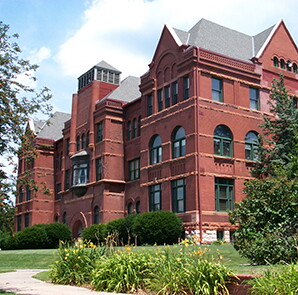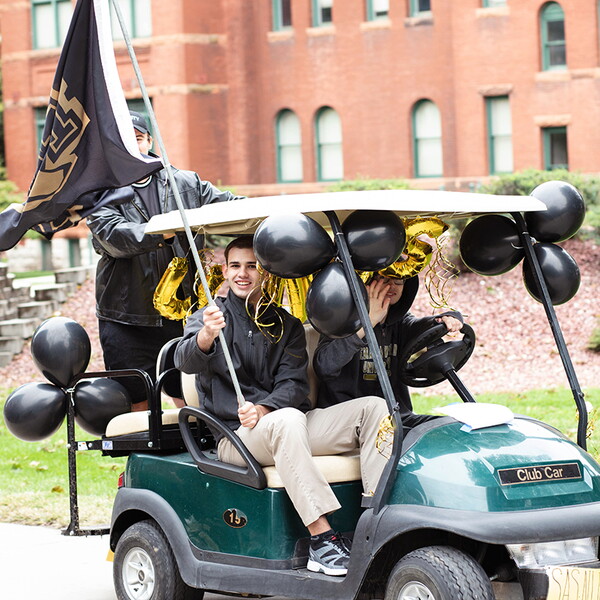A Semester to Remember
One Sunday in 1961, The New York Times featured a large photo of a presidential press conference. It was taken from behind John F. Kennedy, looking out at the press corps. In the middle of the photo, among the nation’s most distinguished reporters and newscasters, sat a 20-year-old college student from Lincoln, Nebraska.
John E. Sampson (’63) still has that newspaper clipping and remembers the thrill of sitting in that room. The Nebraska Wesleyan junior was in the nation’s capital thanks to NWU’s Washington Semester, the precursor to today’s Capitol Hill Internship Program (CHIP).
As part of the program, each student was responsible for writing a monthly article for The Wesleyan, NWU’s student newspaper. Sampson had decided he wanted to report on a presidential press conference, so he wrote a letter to Pierre Salinger, Kennedy’s press secretary. Salinger cordially invited him to attend and gave him instructions on where to go and how to pick up a press pass.
Kennedy’s press conferences had become so popular that the White House had to move them to a larger venue—the State Department auditorium. Sampson arrived at the auditorium and found his seat. He hadn’t been sitting for long before the President entered and the press corps was back on its feet.
“President Kennedy knew how to handle the press very well, with his humor and clever responses to the questions,” Sampson remembers. “After the conference was over, I waited by myself outside the State Department garage. Shortly thereafter, Kennedy’s car came right passed me, and he gave me a warm smile and friendly wave. I returned to my dorm and wrote a story about the experience for my fellow students back in Lincoln.”
It wasn’t the first time Sampson had seen Kennedy speak. Kennedy had visited the Nebraska Wesleyan campus on his campaign tour and Sampson asked him to sign his history book. Little did he know at the time that the young senator from Massachusetts would indeed make history.
(The Lincoln Journal Star featured a photo of Kennedy greeting attendees. Sampson made an appearance in that one, too.)
Sampson’s father was the Dean of Men at Nebraska Wesleyan, so coming to NWU was an easy decision. Even though he lived at home and commuted to campus with his father, he felt a sense of independence at NWU he hadn’t felt before. The “diversity of the curriculum” allowed him to broaden his interests. And because of the small class sizes and personal attention, he gained his voice and formed lasting relationships with professors and classmates.
His educational journey reached its zenith during the Washington Semester. Suddenly he was away from home, living on his own for the first time. Energized by the impatient pulse of D.C., he was determined to take advantage of every opportunity the city had to offer.
In seizing those opportunities, Sampson continued to inadvertently sneak his way into historic photos. If you zoom in on an image of the 1962 State of the Union address, sure enough, you might see him there—sitting in the gallery above members of Congress, the Cabinet, Supreme Court justices and Joint Chiefs.
“Several weeks before the State of the Union address, I told Nebraska Senator Carl Curtis that I would really like to attend,” Sampson said. “He explained that it was highly unlikely; each U.S. Senator receives only one ticket and he was giving his to his wife. But the morning of the speech, I received a call from Senator Curtis’ secretary inquiring if I still had an interest in attending. Absolutely, I responded, but how would that be possible?”
Senator Carl Curtis was a 1928 NWU alumnus who served on the Board of Trustees and for whom the Smith-Curtis Administrative Building is named. Curtis always made it a point to connect with Washington Semester students and help them whenever he could.
Curtis had left word with a few other senators that if they were not going to use their guest ticket, he had a good use for it. The morning of the State of the Union, the wife of Senator Bourke Hickenlooper from Iowa had a conflict arise. Her ticket was up for grabs.
At that time, the State of the Union was delivered at noon. So as soon as Sampson got the call, he threw on his suit, hopped a bus to the Capitol, picked up his ticket from Curtis’ office, dashed over to the House chamber, and was seated right in time to hear the Sergeant at Arms announce, "Mister Speaker, the President of the United States!”
Sampson doesn’t remember much of the speech, Kennedy’s words having faded in the 57 years since the Washington Semester. But that young, hopeful college student must have been moved, sitting in the U.S. Capitol, hearing Kennedy proclaim:
The Constitution makes us not rivals for power but partners for progress. We are all trustees for the American people, custodians of the American heritage. It is my task to report the State of the Union—to improve it is the task of us all.
Sampson answered Kennedy’s call and took on that task. After graduation, he moved back to Washington and interned at the Office of the Secretary of Defense in the Pentagon and later, after graduate school, worked for the Committee for Economic Development.
At the latter, he helped issue recommendations that led to the adoption of the 25th Amendment on Presidential succession. He also made recommendations on how the federal budgeting process could be improved and how management of both state and local governments could also be improved.
After several years in D.C., Sampson decided to pursue a career in business, which included 27 years of corporate planning and development experience with three Fortune 500 food companies (two of which he served as a corporate executive officer). And from 1996 to 2016, he was the president of Sampson Associates Inc., which helped clients around the country buy and sell businesses.
The Washington Semester may have sent Sampson away from Nebraska Wesleyan, but throughout his life he’s continually returned. He served for 12 years on the Board of Trustees and served eight years on the Board of Governors as the first member who did not live in Nebraska. Even though he had to fly in from Indiana for monthly meetings, his attendance never faltered.
In 2006, he was awarded the Alumni Medal of Honor.
Sampson has been giving back to Nebraska Wesleyan every year for more than 40 years, and his philanthropic footprint can be seen all over campus.
His desire to give back started at an early age. When he was still a student at NWU he knew he wanted to name a room in honor of Dr. Glenn Callen, his political science and sociology professor whose classes he loved and whose stories inspired him to enroll in the Washington Semester. Making payments over a few years, he ended up fulfilling his goal before he turned 30. The Callen Seminar Room is located on the second floor of the Cochrane-Woods Library.
Sampson also donated the cross and flame sculpture that stands behind Old Main—the symbol of the United Methodist Church. He funded Sampson Plaza (located at 50th and St. Paul and 50th and Baldwin) to serve as an enhanced front door to campus. And most recently he made a generous gift to the Duane W. Acklie Hall of Science.
“I blossomed at Nebraska Wesleyan,” he said. “I was a different person for having attended there and having participated in the Washington Semester. Giving is just my attempt to repay some of what I gained.”




